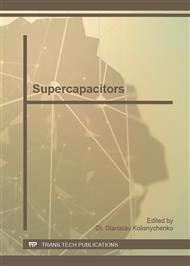[2]
M. Chinchilla, S. Arnaltes, and J. C. Burgos, "Control of permanent-magnet generators applied to variable-speed wind-energy systems connected to the grid," IEEE Trans. Energy Conversion, vol. 21, no. 1, pp.130-135, Mar. 2006.
DOI: 10.1109/tec.2005.853735
Google Scholar
[3]
Nishad Mendis, Kashem M. Muttaqi, Saad Sayeef and Sarath Perera, "Application of a Hybrid Energy Storage in a Remote Area Power Supply System", 2010 IEEE International Conference.
DOI: 10.1109/energycon.2010.5771747
Google Scholar
[4]
I. Vechiu, J.M. Vinassa, H. Camlong, "Hybrid Energy Storage Systems for Renewable Energy Sources Integration in Microgrids: A Review", IPEC 2010.
DOI: 10.1109/ipecon.2010.5697053
Google Scholar
[5]
T. Ise, M. Kita, A. Taguchi (2005), "A Hybrid Energy Storage with a SMES and Secondary Battery", IEEE Transactions on Applied Superconductivity, vol. 15, no. 2, 1915-1918.
DOI: 10.1109/tasc.2005.849333
Google Scholar
[6]
Suryanarayana Doolla, Jayesh Priolkar, "Analysis of Frequency Control in Isolated Microgrids", 2011 IEEE PES Innovation Smart Grid Technologies – India.
DOI: 10.1109/iset-india.2011.6145376
Google Scholar
[7]
W. Li, G. Joós (2008), "A Power Electronic Interface for a Battery Supercapacitor Hybrid Energy Storage System for Wind Applications", Power Electronics Specialists conference IEEE, p.1762 – 1768.
DOI: 10.1109/pesc.2008.4592198
Google Scholar
[8]
C. Abbey, K. Strunz, G. Joós (2009), "A Knowledge-Based Approach for Control of Two-Level Energy Storage for Wind Energy Systems", IEEE Transactions on Energy Conversion, vol. 24, no. 2, pp.539-547.
DOI: 10.1109/tec.2008.2001453
Google Scholar
[9]
Y. Hu, Z. Chen, "Modeling of Frequency and Power Control in An Autonomous Power System with Wind Turbines and Diesel Generation Units", 2005 IEEE/PES Transmission and Distribution Conference & Exhibition: Asia and Pacific Dalian, China.
DOI: 10.1109/tdc.2005.1547162
Google Scholar
[10]
Kenji Amei, Yukichi Takayasu, Takahisa Ohji, and Masaaki Sakoi, "A maximum power control of wind generator system using a permanent magnet synchronous generator and a boost chopper circuit" [C]. Power Conversion Conference, 2002(3):1447-1452.
DOI: 10.1109/pcc.2002.998186
Google Scholar
[11]
K. Rudion, Z. A. Styczynski, N. Hatziargyriou, etc. "Development of Benchmarks for Low and Medium Voltage Distribution Networks with High Penetration of Dispersed Generation[C]", 3rd International Symposium on Modern Electric Power Systems, Wroclaw, 2006.09
Google Scholar
[2]
S. Papathanassiou, N. Hatziargyriou, K. Strunz, "A Benchmark Low Voltage Microgrid Network", Proceedings of the CIGRE Symposium: Power Systemswith Dispersed Generation, Athens, April 2005, Greece.
Google Scholar



